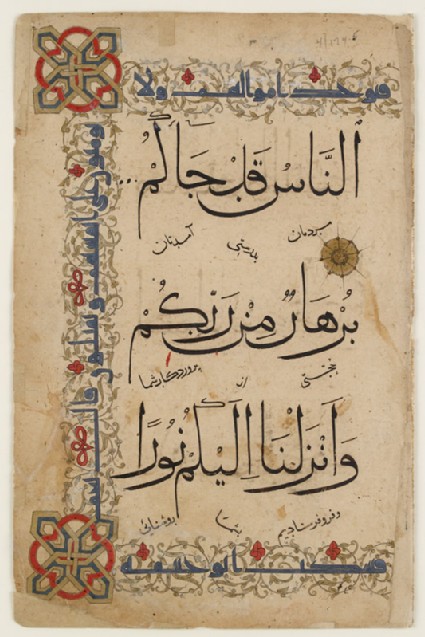Browse: 3051 objects
- Reference URL
Actions
Part of a set with...
Page from a Qur’an in muhaqqaq, naskhi, and kufic script
-
Description
Multi-volume Qur’ans with three or five lines of cursive script per page such as this (Qur’an, 4:174) appear to have been produced in Anatolia in the decades following the Mongol invasion and the conquest of Baghdad, which occurred in 1256. At the same time, the inclusion of a Persian translation underneath each verse indicates that this copy was intended for a Persian-speaking user, suggesting Iran as an alternative place of production.
Framing the text block is a decorative band in kufic featuring excerpts from hadiths, wise sayings attributed to the Prophet Muhammad, that proclaim the virtues of reciting the Qur’an.
-
Details
- Associated place
- Date
- late 13th century - early 14th century
- Material and technique
- ink, colour, and gold on paper
- Dimensions
- page 26.9 x 18.1 cm (height x width)
- Material index
- Technique index
- Object type index
- No. of items
- 1
- Credit line
- Bequeathed by Christopher T. Gandy, 2012.
- Accession no.
- EA2012.69
Glossary (2)
hadiths, kufic
-
hadiths
Muhammad's comments and sayings.
-
kufic
A term denoting various styles of angular Arabic script. Emerged in the early centuries of Islam, kufic soon became the preferred hand to copy holy texts.
Past Exhibition
see (1)Location
-
- currently in research collection
Objects are sometimes moved to a different location. Our object location data is usually updated on a monthly basis. Contact the Jameel Study Centre if you are planning to visit the museum to see a particular object on display, or would like to arrange an appointment to see an object in our reserve collections.
© 2013 University of Oxford - Ashmolean Museum



